Identifying and Mitigating Risks in Project Risk Management


Identifying and Mitigating Risks in Project Risk Management
In the world of project management, one can hardly escape the omnipresent shadow of risk. It’s a lurking uncertainty that can either make or break your project, and being able to navigate these turbulent waters is a skill every project manager must master. Welcome to the realm of Project Risk Management, a critical aspect of ensuring the success of any project.
What is Risk Management in Project Management?
In the world of project management, risk is not just a vague notion; it’s the potential for any event, favorable or unfavorable, to impact your project’s outcomes. Risk management is the proactive process of identifying, assessing, and addressing these events before they can disrupt your project. Risks can materialize in various forms, ranging from something as mundane as employee sickness to larger complexities like unexpected cost overruns or supply chain disruptions.
Being prepared for risks is a skill that separates great project managers from the rest, and it’s not limited to avoiding the negatives. You must also seize the opportunities that positive risks present, ensuring they lead to better project outcomes.
Types of Project Risks
To successfully manage project risks, it’s essential to know the lay of the land. Risks can be categorized into several types, and each of them requires a different approach:
1. Financial Risks: These include challenges such as rising costs, inaccurate budget forecasts, increases in labor and materials, low sales, and difficulties in securing funding. These risks often have a direct impact on your project’s finances.
2. Strategic Risks: Strategic risks emerge from errors in strategic decision-making. This can include choosing an incompatible project management methodology, relying on an outdated company culture, experiencing high employee turnover, or investing in technology that’s complex or expensive to use.
3. Performance Risks: Performance risks are often associated with team members and include missed deadlines, project delays, undefined goals, using outdated market research, and scope creep. These risks can seriously impact your project’s performance.
4. External Risks: External risks are beyond the control of your project team and can include factors such as changing laws and regulations, market volatility, inclement weather, vendors’ delays, labor strikes, civil unrest, vandalism, and supply chain issues.
5. Positive Risks (Opportunities): Not all risks are negative. Positive risks, also known as opportunities, can unexpectedly benefit your project. This could include finishing tasks ahead of schedule, staying under budget, surpassing initial goals, optimizing project efficiency with new tools, or profiting from a policy change.
Risk Management vs. Risk Mitigation
Understanding the distinction between risk management and risk mitigation is crucial:
Risk Management: This is the comprehensive process of planning for, anticipating, and dealing with risks, whether they are positive or negative. It encompasses all aspects of risk from identification to mitigation.
Risk Mitigation: Risk mitigation is part of the risk management process and focuses on addressing risks when they materialize. It involves taking specific actions to reduce the impact of risks on your project.
How to Manage Project Risk: A 5-Step Guide
The risk management process is your compass through the turbulent waters of project management. It comprises five key steps: Identify, Analyze, Evaluate, Treat, and Monitor. Let’s delve into these steps to understand how they can help you navigate the world of project risks.
1. Identify Risks
The first step in managing project risk is identifying the potential hazards lurking in the shadows. You must create a list or a spreadsheet of all the risks that might affect your project. This involves consulting your project management expertise and seeking insights from stakeholders, team members, and subject matter experts.
2. Analyze Potential Risk Impact
Risk analysis involves evaluating each identified risk’s probability of occurrence and the potential impact it could have on your project. Create a risk register that outlines each risk, its priority level, and any mitigation plans. You’ll need to record both qualitative and quantitative information to complete this step.
3. Assign Priority to Risks
The assignment of priorities to risks depends on a combination of factors, primarily the probability and impact of each risk. Based on these factors, you can categorize risks as high, medium, or low priority. This categorization will guide your team in focusing their energy on mitigating the most critical risks.
4. Mitigate Risks
Mitigation strategies are your tools for dealing with risks. There are four primary approaches to risk mitigation:
- Avoidance: Use avoidance for risks with a high probability of occurring. For instance, if you’re aware of a vendor’s reputation for poor-quality work, consider seeking a different vendor.
- Acceptance: Accept low-impact, low-probability risks that won’t derail your project if they occur. For example, if you might receive some tulips instead of sunflowers at a wedding reception, you can accept this minor change.
- Reduction: Reduce the probability or impact of medium and high-risk factors through changes in your project plan. This may involve additional resources, time buffers, or contingency budgets.
- Transfer: Shift risks to external parties through insurance policies or outsourcing. While the risk might still occur, its impact on your project will be absorbed by an external entity.
5. Monitor Risks
After implementing mitigation strategies, the final step is continuous monitoring. Assign team members to keep a close eye on specific risks and proactively manage them. This ongoing vigilance ensures you’re ready to tackle any risk that manifests itself during your project’s lifecycle.
Tools to Manage Risk
To navigate the labyrinth of risk management effectively, it’s essential to have the right tools at your disposal. Here are two valuable tools that can structure your risk management efforts:
Risk Management Plan
This is a dynamic document containing all the information related to risk in your project, including an executive summary, risk register, mitigation plans, risk owners, and other pertinent data. Project managers update this document as the project progresses and circumstances evolve.
Risk Register
A risk register is essentially a chart that compiles all the risks associated with your project. It includes their priority levels, mitigation plans, and other critical details. You can either use project management software to create risk registers or build them in a spreadsheet.





